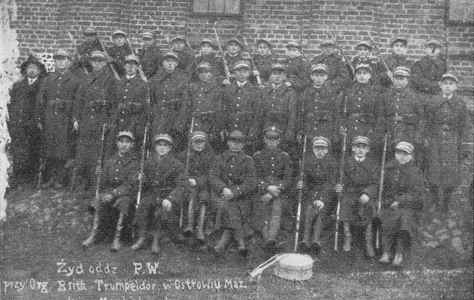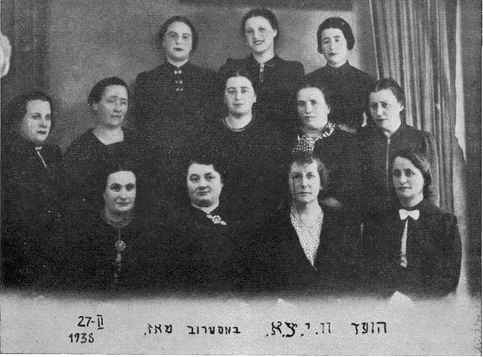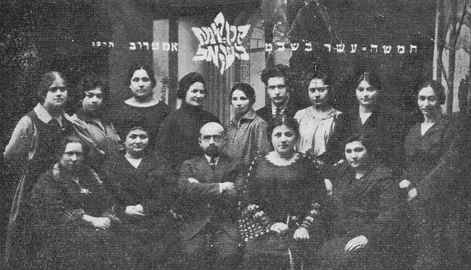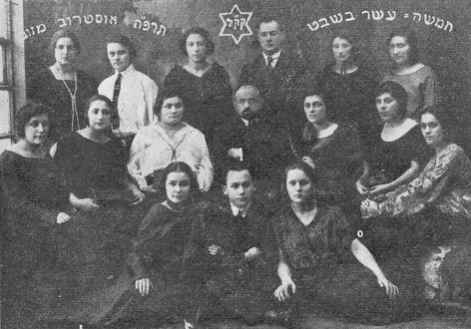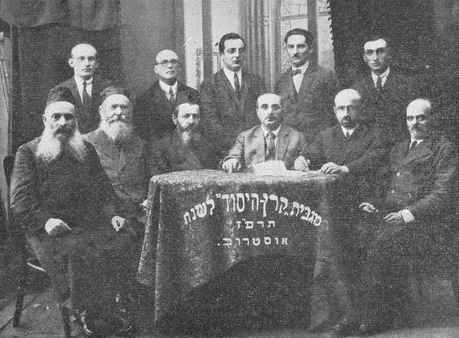Ostrów Mazowiecka
P.W.K.
(The Jewish Military Cadets in Ostrowa)
By A. M-T
Translated by Judie Ostroff Goldstein
In memory of the program for Jews and also the idea that future Pioneers should, aside from learning specific trades, be knowledgeable in self-defense. A group of youngsters had the idea to organize a Jewish Military Cadet program.
The instructors were professional non-commissioned officers. There were exercises with rifles and a sports program. The activities of the Jewish P.W. were the same as the Polish organizations for military cadets, with the Polish name Przysposobienie Wojeskowe.
In the course of two years, the group of almost fifty Jewish youngsters, recruited from Betar and other youth groups received elementary military training.
|
|
Jewish Military Cadets with members of Brit Trumpeldor in Ostrów Maz. |
The Women's Organization “WIZO”
By Chana Holcman, Tel-Aviv
Translated by Judie Ostroff-Goldstein
With the growth of the Zionist movement in Poland, the Zionist Women's Organization “WIZO” held a position of respect. In 1927, volunteer instructors arrived from Warszawa in order to organize “WIZO” chapters and enroll members from among the national minded Jewish women in provincial towns. This happened during a difficult economic crisis in Israel, when various impoverished Israeli pioneers were returning to Poland and trying to discredit Israel and our national institutions. The Zionist organization decided that by strengthening Zionist activities they would be able to fight against the disillusioned returnees.
It also created a new era for Jewish women, enabling them to break free of their existence as mothers and housewives and take part in community life in general and Zionism in particular.
With the establishment of “WIZO”, women began to understand that they should not and must not stand on the sidelines where building Israel was concerned, since women could have such a great influence in the work, especially in raising their children in the Zionist spirit.
At that time, a “WIZO” chapter was founded in Ostrowa under the leadership of Sara Tejtel.
A Delegate from the Warszawa central office was sent to Ostrowa – Mrs. Bella Pezner. After her successful and inspiring speech she bewitched everyone with descriptions of Israel, brought the women to tears and captured their hearts. They were willing to assist in building their own land.
She also displayed a strong organizational ability and in a very short time the number of members grew from tens to hundreds.
An important step in the growth of “WIZO” was the 1928 conference in Warszawa, Poland (with the participation of Mrs. Riwka Zyw from London). The writer participated as a delegate, brought greetings on behalf of the Ostrów Mazowiecka branch, gave a report and actively participated in other aspects of the conference.
At the conference it was decided to organize “WIZO” work on a grand scale and the delegates returned home full of energy and purpose. Work began by discussing Zionist ideals, and enlightenment work, relief work for pioneers, educating the children about Zionism, supporting the Tarbut schools, organizing Jewish women in the Zionist movement and the main activities Keren Kayemet and Keren Hayesod. At a meeting held after the conference, the writer gave a report on the decisions made at the conference. The chairwoman, Mrs. Sara Tejtel, was leaving for Russia for a year, so the writer was elected chairwoman for the organization and successful directed the work for a broad recruitment drive that doubled the membership. Those who helped with the work were Gitl Margolis, Nechama Goldsztejn, Mrs. Kywejko, Sonja Kac, Mrs. Rapaport and Mrs. Paulina Goldberg.
In 1929, due to my move to Warszawa, the dedicated, hard working, generous volunteer Mrs. Sara Tejtel, who in the mean time had returned from Russia, was once again elected chairwoman.
The contribution of “WIZO” in Ostrowa to Keren Kayemet was an important one. The women went out collecting on tag days, sold fruit for Tu B'shvat and ran the traditional Purim Bazaar that took a lot of time to organize. The “WIZO” bazaar was popular and each year attracted new believers in Israel.
The blessed work of “WIZO” had survived difficult times – aliyah to and emigration from Israel. But the greatest downfall came in 1939, when the Nazi murderers occupied Ostrowa. The “WIZO” institutions were destroyed, but more importantly the volunteers and comrades were murdered. We mourn them, together with all the other martyrs, hy”d.
|
|
“WIZO” Committee in Ostrów Maz. 27 February 1938 |
The Work of Keren Kayemet L'yisroel
By Arija (Leib) Margolis
Translated by Judie Ostroff Goldstein
When Reb Michel, son of Isser Tejtel returned from Russia in 1921(where he had been exiled, by the Russians from 1915-1921 during World War One and the war between Russia and Poland), the work for Keren Kayemet [Jewish National Fund – JNF] was renewed in Ostrowa.
I do not know about the work of JNF before the First World War. I was not in Ostrowa. I believe that there was probably JNF Zionist activity prior to the war (during the war there was no Zionist work). In 1921 it was renewed. The principal work was to distribute the five hundred blue pushkes in town.
The Deputy for the JNF was the Zionist activist Reb Michel Tejtel. He was so devoted and his work was exemplary; Vice-deputy and in charge of the periodic and incidental collections – the writer; Secretary – the young man Gdalia Elkes (today the well-known historian Dr. Gdalia Elkushi in Jerusalem).
The work of JNF spread and the funds grew; especially in 1925 after the General Polish Conference in Warszawa between Rosheshone and Yonkiper with participation of renown Zionist leader Usyszkin and a special delegate from Israel to help revive the work in Poland. The stabilization of Polish currency (the transition from Mark to Zloty) by the famous Finance Minister Grabski, especially with his tax system in respect to the Jewish population, had a strong influence on the so called “Grabski Aliyah” to Israel.
At the same conference, (that made such a large impression and brought about the revival of Zionist work in Poland and especially the Jewish National Fund), the representative from our town was the writer. As a result we worked harder and the funds grew. 3,700 Zlotys were collectedin 1925 and 5,110 Zlotys in 1926. But in 1927, when the famous crisis occurred in Israel and several of the new immigrants returned to Poland, the fund fell to 2,347 Zlotys.
In 1928, when the situation in Israel was a little better, the fund collected 3,524 Zlotys. And so the collections went up and down in response to situations in Israel and Poland. The amount collected in 1929 was 3,226 Zlotys; in 1930 – 3,820 Zlotys. It should be noted that in the 1930's the growth of Hitlerism in Germany also had an effect on the economy and the attitude of Poles towards Jews.
The work of Keren Kayemet included first and foremost the distribution of pushkes. Youngsters from all Zionist parties and factions went to empty the pushkes every month. From time to time, as an example for the youth, older Zionists along with Deputy Michel Tejtel, would also do collections.
Collections went on the entire year, from Rosheshone until Tish b'Av, with greeting cards for “Rosh Hashanah” and the contribution plate erev Yonkiper in the schools, botei medrashim
|
|
Khamishoser bi-Shvat [Tu bi'shvat] Keren Kayemet committee |
|
|
Khamishoser bi-Shvat Keren Kayemet 5685 [1925] Ostrów Maz |
and shtiblakh. We did include the shtiblakh and put collection plates there, but nobody contributed anything.
Donations to commemorate the dead were done in two ways, Chanukah collections and the distribution of packages of fruit from Israel; figs, dates and nuts, through the auspices of “WIZO” for Khamishoser bi-Shvat [Tu B'shvat]. This work was done every year. The nuts were distributed through Keren Kayemet Central in Warszawa. I would like to mention a subsequent episode: once for Khamishoser bi'Shvat I ordered two skids from Warszawa with speeches of Dr. Jehusza Thon, Dr. Jehusza Gotlieb, Jozef Heftman and Icchok Grynbaum. In the invitation to Zionist comrades I mentioned that the above mentioned people would speak. It was understood that everyone would come. Then I turned on the gramophone so we could hear the speeches. The women could not argue because I had said we would only hear them.
There were also periodic collections: at Purim – by way of sending shalakhmones; Lag B'omer – flower day [tag day]; erev Shavues – bringing young men to the “Tarbut” school etc.
Collections were also made at engagement parties, weddings, circumcisions and other special occasions. Comrades from all the Zionist groups and youth organizations worked together collecting money.
The principal attraction was the Purim Bazaar run by Keren Kayemet, which brought in large sums of money. Preparations for the Bazaar took several months. “WIZO” did the principal work along with the youth organizations under the leadership of the energetic “WIZO” chairwoman Mrs. Sara Tejtel. Every youth group had a booth with their products. The largest and most beautiful kiosk was always that of “WIZO” and the Jewish National Fund benefited.
The intense work, full of life and enthusiasm, went on all year and gave the youngsters purpose. From time to time representatives from Central in Warszawa would visit, such as Dawid Tenenbaum, Abraham Bialopolski, Dow Ber Malkin, Alter Clarman and others.
In 5691 [1930] there was a district conference for delegates from the towns and villages of the area, attended by the Director of Central in Warszawa, Y.L. Bloch and the delegate from Israel Arija Lichtinger-Naor.
|
|
A fund-raising day |
We also received visits from representatives of the Jerusalem head office. Rabbi Jeshaja Szapiro; Jakob Melamed visited during the last days of Sukes in 1934; Meier Hazrachi – Propoganda Director-Jerusalem; Mrs. Leah Widrowiec – “WIZO” delegate; Mrs. Dewora Lekhower and many others whose names I cannot remember.
In Elul 5690 [August 1930] (after a long illness), our beloved and respected deputy, Michel Tejtel, died. The writer took over as deputy. In 1935, before my aliyah to Israel, a comrade from the General Zionist Organization, Szmul Lewitow was nominated as deputy and remained so until the outbreak of the Second World War in 1939. He was murdered along with the other martyrs hy”d.
The Founding and Work of Keren Hayesod
By Arija (Leib) Margolis
Translated by Judie Ostroff Goldstein
The first day of Passover 1921, a short time after Reb Michel son of Isser Tejtel returned from Russia, several Mizrahi Zionists, who prayed in the new besmedresh, decided to meet in the afternoon at Icchok Zurach Orlański's house (a brother of Rabbi Orliański who died in Hebron, Israel). We discussed founding a Keren HaYesod committee.
|
|
Keren HaYesod Committee 5687 [1927] |
Attendees were: Reb Michal son of Iser Tejtel, Reb Michal son of Zew Tejtel, Eliahu Tejtel, Icchok Zurach Orlański, Gdalja Dawid Morgensztern, Icchok Morgensztern, Menachem Drozdowski, Dawid Welczer, Szlama Szklaniewicz, Lejb Margolis and others.
Everyone agreed to form a committee and not wait for approval from Warszawa. Our town was the fourth in Poland to spontaneously found a provisional Keren HaYesod committee before holding a general meeting.
The President was Reb Michal son of Iser Tejtel – Chairman was Reb Michal son of Zew Tejtel – Secretary-Treasurer was Szlama Szklaniewicz.
During Passover we held the first general meeting in the old besmedresh to talk about the work of Keren HaYesod and the importance of building Israel as a place of refuge for persecuted and tortured Jews. The speakers were Reb Michal son of Iser Tejtel, Szmul Bernholc (known as a good speaker) and L. Margolis.
Soon after Passover, we sent a report to the central office in Warszawa, confessing and asked them to send us an instructor. Jikir Warszawski arrived from Warszawa, but without enough information, because at the London headquarters they still had not instituted a general work plan. We used the system that had been in place for Keren HaGolah and received a thank you from Warszawa signed by the President Awraham Podliszewski and Secretary, Jeshaja Morgensztern.
At the end of summer, in Elul [August], Dr. Flaszner arrived with a work plan from London headquarters for selling bonds. Each shekel [share, bond] was worth five Pounds Sterling and would come due in five years. (This was decided at the Zionist conference in London in 1920 for collecting 25 million pounds sterling in five years.)
At this time, Szlama Szklaniewicz resigned as Secretary and I took over his position. Dr. Flaszner stayed with us for a week and spoke in the new besmedresh on Shabes. After havdalah he went to the hotel. There was a line of people waiting to enroll for bonds by paying one pound (five dollars) as the first installment. These bonds were to pay a dividend. So many people had been inspired and they came to sign up. For the most part they were ordinary Jews – artisans and small shopkeepers. A lot of money was collected.
However in 1921-1922 the aforementioned leaders of the Zionist Organization and Directors of Keren HaYesod realized that the system of selling pledges with interest and dividends did not suit all of Jewish society. By selling bonds, in the manner of a share society with profits and not having a “folk-movement” that spoke to the heart, with a sense of building the country, a lot of Jews felt left out. Also the system was not practical, because the earnings would go into the shareholders' pockets. They decided to simply collecting tithes.
In 5682 (1922) the following delegates from Central in Warszawa came to visit: Rabbi Icchok Borg and Cwi Szapiro because they had already worked with the new system of gathering pledges, the minimum was six dollars a year and they would be cashed at a bank. The fund-raiser was a success. Rabbi Borg spoke in the besmedresh and he made a strong impression with his heartfelt, simple speech.
Delegates from Central came to help with the yearly fund-raiser. Rabbi Icchok Borg came many times. Others delegates who came were: Icchok Berger, Oszer Kolodni, Dr. Israel Chaimson, Chaim Glojbersohn (Ben Mamin), Dr. Arja Tarlo, Jakow Gurzalka, Naftali Grabowski, Israel Rytow (living in Israel), Mordchai Ribejkow and Matitaju Gliksberg. Once, famous Zionists opened the drive: Dr. Jehusza Gotlieb, Jozef Heftman and others. Several delegates from Israel also helped with the work in Ostrowa (Rabbi Ostrowski and Dow Perlmuter z”l).
During the fund drives, that lasted a week or two, there was a holiday spirit. The volunteers worked with joy and dedication. The work was difficult mainly because at that time a large number of people were against Zionism in our town. But thanks to the volunteers the work became easier and our town was one of the leading contributors in Poland.
We sent representatives to the conferences. To the first convention, that took place 12 to 14 February 1923 in Warszawa, in which Nachum Sokolow participated, we sent Reb Michal son of Iser Tejtel and Lejb Margolis who took part in the debates.
At the special Conference that took place during the economic crisis of 1926 in Israel, the following took part: Lejb Jaffe from the Executive in Jerusalem, also Mordchai Kohn and Lejb Margolis. There were delegates from over fifty towns who carried out their work with distinction.
From 1921 to 1939 the following served, at some time, on the committee. Reb Michal son of Iser Tejtel, Reb Michal son of Zew Tejtel, Icchok Zurach Orlański, Icchok Morgensztern, Szlama Szklaniewicz, Awraham Trejster, Pinchus Rajgrodski, Awraham Cwi Szwarc, Mosze Holcman, Mordchai Cohen, Lejb Margolis, Chaim Glinka, Jechiel Leszcz, and others whose names I can no longer remember.
The principal work was lead by the President Reb Michal son of Iser Tejtel, Mordchai Kohn, Icchok Morgensztern, Pinchus Rajgrodski, Chaim Glynka and the Secretary Lejb Margolis.
After the death in 1930 of Reb Michal Tejtel, the President of the committee, the writer was appointed to that position.
In 1935, with my aliyah to Israel, Pinchus Rajgrodski hy”d (murdered during the Holocaust) took over as President until the outbreak of the Second World War in 1939.
The “Bund” in Ostrowa Between the Two World Wars
By A. M. O.
Translated by Judie Ostroff Goldstein
The older Bund generation was not very active during this period (the left had taken over many of the Bund sympathizers), but the young Bundists were.
The Warszawa “Yungt Veker” [“Awaken Youth”] was well circulated among young Bundists and they would contribute to newspaper drives. The 7th August 1927, we were reading in the “Yungt Veker” about a gathering of young, district Bund members which took place in Ostrowa - Lej'cze Lewkowicz.
In 1931 the youth-Bund in Ostrowa celebrated its 20th anniversary. Lej'cze Lewkowicz wrote the following in “Yungt Veker” of 1st July 1931:
“20 years of Tzukunft, this anniversary brings so much enthusiasm, to prepare us for the passion in young hearts, the celebration must carry forth and give form to the past and the struggle.
Headquarters is full to over flowing. Red banners are fluttering, the “Yunge Gvardia” [“Young Guard”] is sung.
The celebration was opened by Leon Kraft. Apel gave greetings from the Bund and from the PPS [Polish Socialist Party] – Leszniewski, Abraham Hersz spoke on behalf of the “Culture League” and Comrade Elje – on behalf of the older Bundists. Sokolik gave an overview of Tzukunft history. Lucyne spoke about educating young Socialists.
The choir sang and there were also recitations, after which we sat around tables and songs of freedom and courage, hope and creation – rang out.
In the “Yungt Veker” of 15th June 1932, we read about a gathering of the Tzukunft in Warszawa, where twenty-three Tzukunft members from Ostrowa took part:
“As in many towns, the young Bundists from Ostrowa had leftist origins (from Khmurner's heder), because they had to adapt to the mood of the young workers in the Jewish streets, who were despised by the Polish semi-Fascists and pro-Feudalists”.
In 1936-1937 when Ostrowa had just gone through a wave of excesses and pogroms, the Bund together with PPS and other groups tried to fight against them on the Polish streets. But it did not help. Many Ostrower Bundists, as well as Communists and Poalei Zionists, left Ostrowa and travelled overseas and by the outbreak of the Second World War, very few young Bundists were still in Ostrowa.
Ostrowa Details (New Era)
By A. M. O.
Translated by Judie Ostroff Goldstein
J. Bernsztejn, a Bundist activist in Argentina, a member of the Buenos Aires community, knows the story about the Navaredok Yeshiva in Ostrowa, which had an influence on the entire area. The yeshiva published its own newspaper in Yiddish, “Arbeter Luakh” [Workers' Almanac] in 1920, publisher “Lebns Fragn” and it can be found in the “Bund” archive in New York.
The Jewish workers Trade Movement had three hundred twenty-nine members, men and women, the majority were garment workers. The Worker Cooperative “Unity” had two hundred twenty-eight members.
The Bund had thirty-six party members as well as supporters.
The Youth-Bund Tzukunft had ninety members.
The Left and Right Poalei-Zion had scores of members and many more sympathizers.
The Jewish Communists had many members and many more sympathizers.
In the 1930's during the “trials” about “right” and “left” in Moscow, a lot of Jewish Communists in Ostrowa began to lose confidence and belief in the party. They were disappointed by what they had found.
The “Yiddisher Arbets Klas” [“Jewish Working Class”] was published in Łodż in 1936, which dealt with the important issues facing Jewish workers in Poland. Over and over they raged against anti-Semitism in Polish towns and villages, lead by “Endekes” and several “patriots” from the government.
Then an “Arbeter Congres” [“Workers' Congress”] was created in Ostrowa, including the right and the trade unions, to fight against anti-Semitism. A meeting was called at City Hall and over eight hundred people from the Jewish working class came to air their troubles and show their readiness to fight against hatred. This was the first time that a Jewish gathering of this size took place in Ostrowa.
